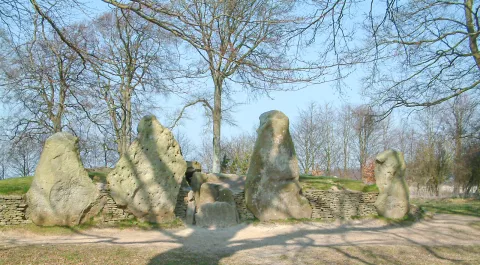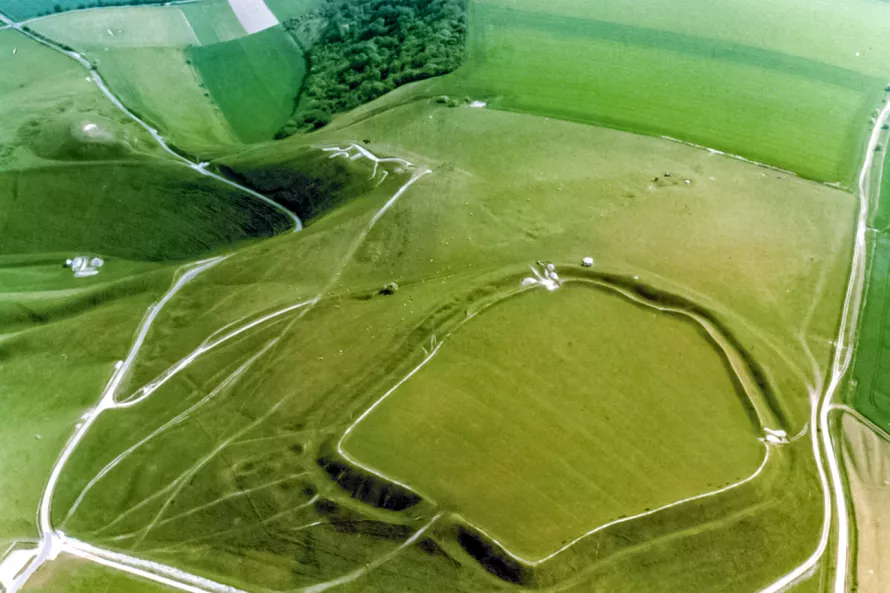The earliest evidence for human activity in the Uffington area comes in the form of burials. On the flank of White Horse Hill, alongside a track leading to the Horse, is a long earthen mound. Excavations in the mid 19th century found a central chamber and a large urn (since lost). This was probably a burial mound of between four and five thousand years ago.
This prehistoric mound was important to Roman Britons, a mysterious work of the ancestors. Around AD 300 they also buried their dead there. Distinctively, many of these bodies were decapitated after death. This is a not uncommon local practice at this period and suggests the community was not yet Christian.
Before this, in the early Bronze Age about 4000 years ago, people constructed round barrows on the ground above the site of the White Horse. These ancient mounds were recognised by Anglo-Saxon newcomers, who in the sixth century AD re-used them to bury their dead, thus claiming their rights to the land.
So White Horse Hill was, for a millennium, a high place where the ancestors were buried – their graves outlined against the sky and visible to the communities in the valley below.
No late prehistoric burials have been found on White Horse Hill, but this was a time when remains were customarily placed in rivers in this region. Still today people frequently request that their ashes should be scattered on the Hill, leaving no trace for future archaeologists.

The Ridgeway
The ancient trackway, the Ridgeway, runs past White Horse Hill and may once have passed through the hillfort before its eastern entrance was blocked. The Ridgeway runs along the chalk scarp eastwards, to cross the Thames near Goring and join the Chilterns. To the west is passes close to the great henge monument at Avebury.
The age of the Ridgeway is much debated. It may have emerged as a routeway for migrating reindeer and horses 12,000 years ago. It is mentioned in Anglo-Saxon charters, however, the clearly defined path visible today is much more recent.
Wayland’s Smithy
Less than 3 kilometres from White Horse Hill is the megalithic chambered tomb of Wayland’s Smithy. Huge sarsen stones - a hard sandstone found eroding through the younger chalk – were dragged to the site, probably from the nearby dry valley by Ashdown House. A scatter of sarsen stones can still be seen lying in the valley.
Wayland’s Smithy has two phases. The earlier, smaller tomb dates to about 3700 BC. Several of the human remains were pierced by flint arrowheads, suggesting that they were killed in a raid. Flint nodules occur naturally in the chalk, and this silicate was for millennia worked by humans into razor sharp blades, scrapers, axes and projectile points.
Later, about 3500, the larger mound was placed over the earlier tomb marked with huge sarsen stones blocking a stone chamber. Unfortunately, the human remains and Neolithic finds are long gone, scattered by grave robbers.
The name ‘Wayland’s Smithy’ refers to the Norse and Anglo-Saxon smith god and is recorded in Anglo-Saxon boundary charters 1000 years ago. Local legend has it that a horse tethered outside ‘the smithy’, with a financial offering, will be re-shod. The chambered tomb seems to be part of the elaborate landscape mythology, linking ancestral monuments to the White Horse itself.

Uffington Castle
The ramparts of Uffington Castle dominate White Horse Hill. Our excavations in the late 1980s and 1990s revealed that the hillfort was first fortified around the eighth century BC. The rampart was topped by a palisade of wooden stakes and there were impressive entrances on the west and east sides. Later the ramparts and outer ditch were enlarged and the eastern entrance blocked.
Surprisingly, there was relatively little evidence of contemporary occupation in the hillfort. In contrast, excavations at nearby hillforts – Segsbury Camp and Alfred’s castle – showed more evidence of having been used by farming communities in the Iron Age for seasonal gatherings or even more stable occupation.
Hardwell Camp
Another hillfort, Hardwell Camp, on the lower slopes of the chalk west of Uffington Castle has never been excavated. In the Anglo-Saxon boundary charters it is known as Tell’s Fort, named for the Anglo-Saxon archer god and brother of Wayland. The two gods occur together on the Anglo-Saxon Franks Casket in the British Museum.
It seems probable that Uffington Castle was primarily a focus of ceremonial and religious activities connected to the White Horse. Ritual activities seem to have continued in the Roman period.
Where people lived
So the people who built Uffington Castle and carved the White Horse probably lived in scattered farming communities, both in the Vale and on the Downland. We excavated one of these higher sites nearby at Tower Hill, in 1998. A spectacular hoard of freshly minted bronze axes and other gear lay buried in the doorway of a round house, while small rectangular fields covered the Down.
We found another settlement of round-houses, of the same eighth century date, in the Vale, alongside the railway line near Uffington. These people would have had a great view of White Horse Hill.
More recently Cotswold Archaeology excavated a similar prehistoric farmstead with later Romano-British settlement and a decapitated burial at Letcombe Bassett a few kilometres east of the Horse.

